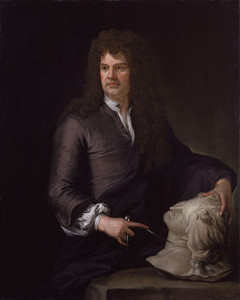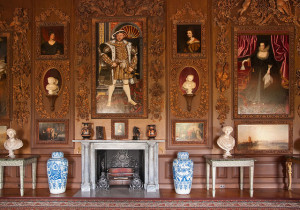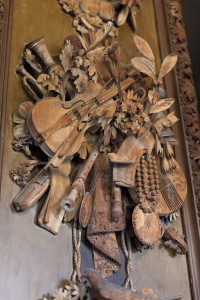In the spring of 1986 I absorbed a museum exhibit that ranks as the best in my experience. The Treasure Houses of Britain was seen by almost one million people during its six months at Washington’s National Gallery of Art. Like most of the visitors I was amazed, impressed, “gobsmacked” not only by the sheer opulence of the treasures but also by their artistic merit. The memory of that exhibit is as fresh in my mind today as it was when I first wrote on the subject years ago.
According to the National Gallery of Art (DC) website more than “700 objects were gathered from more than 200 homes representing collecting and domestic arts from the 15th to the 20th century.”
Above is one of seventeen period rooms that were constructed to display the objects. It is obviously the most ambitious project ever undertaken by the NGA. Gervase Jackson-Stops chose the art work and the exhibit was structured to showcase each period of collecting by the great families of England.
It was at this exhibit that I first saw the work of master woodcarver Grinling Gibbons.  The piece on display was a carving of fish and game, not my favorite subject matter, but the delicacy of the carving amazed me. The work was done in the days before dental drills and dermal tools made intricate carving more accessible. Gibbons work shows an attention to detail that defies the imagination of my contemporary “hurry up and get it done” approach to the craft projects I have undertaken.
The piece on display was a carving of fish and game, not my favorite subject matter, but the delicacy of the carving amazed me. The work was done in the days before dental drills and dermal tools made intricate carving more accessible. Gibbons work shows an attention to detail that defies the imagination of my contemporary “hurry up and get it done” approach to the craft projects I have undertaken.
Grinling Gibbons was born in Rotterdam in 1648. It’s possible his father was an Englishman who worked with Inigo Jones, who introduced Italianate Renaissance design to the English. Grinling Gibbons came to England in 1667 his talent obviously developed in the nineteen years before he arrived. He was discovered working “in a poor and solitary thatched hut in Kent” by diarist John Evelyn who introduced him to King Charles II through the intercession of Christopher Wren.
His work can be found in dozens of houses and public buildings throughout Britain, including Petworth, Blenheim, Kirtlington Park and also at Windsor, and many of Wren’s London churches. Gibbons and his “workshop” added immense detail and beauty to St Paul’s, London. Arguably the greatest example of his work is found at Petworth in the Carved Room, a small segment of which is shown above. Ignore the paintings (yes, I know that’s not easy) and look at the work in wood that fills the wall like we use wood paneling today.
Gibbons and his workshop worked in mediums besides wood, but wood best suited the detailed handiwork for which he, himself, is best known. To the right is a detail of his work in wood.
best suited the detailed handiwork for which he, himself, is best known. To the right is a detail of his work in wood.
Last year when I visited Biltmore in Asheville North Carolina I noticed a fine wood carving over the mantle in one of the rooms. I’ve been meaning to call the curator and find out if it was by Gibbons. I might do that tomorrow and I will let you know what I find out.
Are you familiar with Gibbons? But, more important tell us about an exhibit that made you stop in your tracks in awe and appreciation.


Thanks for such an informative article, Mary. I found it intriguing that you were stopped in your track by this exhibit, particularly Mr. Gibbons masterworks. What as it, do you think, that you discovered or concluded about art, or the world, by viewing this exhibit? When visiting the Barnes Museum in Philadelphia for the first time three years ago, I walked through 4 small rooms and saw hundreds of paintings – over 100 works by Cezanne, several masterworks by Van Gogh, Picasso, my favorite Claude Monet – hung in ‘ensembles’ Mr. Barnes himself designed based on ‘what he liked’. I too, felt gobsmacked, as you were, by the variety of genius, as well as by the fact one man had enough money to buy about 1,000 paintings over 30 years that are worth a few billion. Yes, with a b. All in 4 rooms the size of a living room in an upper class home. I felt like I was a cultural glutton after viewing so much beauty in three hours. And I’ll never forget it.
What did I discover about art by viewing this exhibit? Well, Emelle, thinking back thirty years (!) the exhibit impressed me with the ability humanity has to make an art form out of any creative effort. It was not just Gibbons work. It was the furniture, the ceiling moldings, the painted ceilings, the floors. People lived in a world even more fragile than ours in terms of health and life expectancy and they still valued art. Thank you for your thoughtful answer. The Barnes is on my list.
Wow, thanks for sharing this, Mary. While I was in England I got to see some of the carvings by Grinling Gibbons in person and they are wonderful. I hope everyone will click on the first two images you shared for a better look than the blog format allows.
As for best exhibits, that’s so difficult to answer. Maybe I am easily “gobsmacked”. Recent visits include the new glass art exhibitions at the Corning Museum of Glass and the Morse Museum in Orlando, which features Tiffany glass, not “our” period, but very beautiful.
Corning? I was there years ago. It was the glass blowing that amazed me. Thanks Elena, Iwill put it on the list again. Last week I was at the Sandwich Glass Museum on Cape Cod which once again proved that I love watching people work with glass. And thank you for the suggestion that readers click on the image. I will add that to my list too!
Great post, Mary! A new artist to add to my list. I had not heard of Gibbons before and I can’t think why because his work is exquisite.
I have been so very fortunate in my life to visit some wonderful museums. I visited the British Museum numerous times as a child. Seeing the Rosetta Stone, the Elgin Marbles and the King Tut Exhibit had a profound effect on me and made me a lifelong student of history.
As an adult I spent days in the museums of Amsterdam. The Rijksmuseum in Amsterdam is amazing and seeing The Night Watch for the first time made me cry. As did spending a day in the Van Gogh museum. The Anne Frank House and Museum struck me with awe, especially seeing her actual diary under glass.
Lousia, when are you writing your auto-biography? I want to read it. Yes, the British Museum is a feast for the visitor. But overwhelming for those who are there only one time (so far) I envy your visits throughout childhood.
Mary, great post, very thought-provoking. The work of Grinling Gibbons has always amazed me (besides, what a great name!) but I’ve always associated his work more with churches than the Great Houses. Makes sense, of course –he was indeed a genius at his art, and they wanted the best of the best for their homes.
As for exhibits, I think I must be like Elena –easily gobsmacked, LOL! Happens every time I see a good one.
I wish I could remember where I saw wood carvings that I think must have been Grinling Gibbons. Windsor Castle? or maybe Chatsworth or one of the other country houses.
I love art galleries, almost any of them, displaying almost anything, but I remember one painting from our National Gallery of Art that affected me when I was a little girl and continues to fascinate me today. Watson and the Shark by John Singleton Copley. http://www.nga.gov/feature/watson/watsonhome.html
I could stare at that painting all day! Something about the danger, action, emotion, and drama that was captured in the painting.